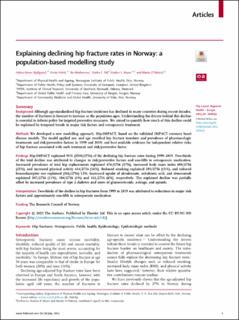| dc.contributor.author | Kjeldgaard, Helena Kames | |
| dc.contributor.author | Holvik, Kristin | |
| dc.contributor.author | Abrahamsen, Bo | |
| dc.contributor.author | Tell, Grethe S. | |
| dc.contributor.author | Meyer, Haakon E. | |
| dc.contributor.author | O’Flaherty, Martin | |
| dc.date.accessioned | 2023-06-13T13:06:33Z | |
| dc.date.available | 2023-06-13T13:06:33Z | |
| dc.date.created | 2023-05-10T12:37:15Z | |
| dc.date.issued | 2023 | |
| dc.identifier.issn | 2666-7762 | |
| dc.identifier.uri | https://hdl.handle.net/11250/3071183 | |
| dc.description.abstract | Background Although age-standardised hip fracture incidence has declined in many countries during recent decades, the number of fractures is forecast to increase as the population ages. Understanding the drivers behind this decline is essential to inform policy for targeted preventive measures. We aimed to quantify how much of this decline could be explained by temporal trends in major risk factors and osteoporosis treatment. Methods We developed a new modelling approach, Hip-IMPACT, based on the validated IMPACT coronary heart disease models. The model applied sex- and age stratified hip fracture numbers and prevalence of pharmacologic treatments and risk/preventive factors in 1999 and 2019, and best available evidence for independent relative risks of hip fracture associated with each treatment and risk/preventive factor. Findings Hip-IMPACT explained 91% (2500/2756) of the declining hip fracture rates during 1999–2019. Two-thirds of the total decline was attributed to changes in risk/preventive factors and one-fifth to osteoporosis medication. Increased prevalence of total hip replacements explained 474/2756 (17%), increased body mass index 698/2756 (25%), and increased physical activity 434/2756 (16%). Reduced smoking explained 293/2756 (11%), and reduced benzodiazepine use explained (366/2756) 13%. Increased uptake of alendronate, zoledronic acid, and denosumab explained 307/2756 (11%), 104/2756 (4%) and 161/2756 (6%), respectively. The explained decline was partially offset by increased prevalence of type 2 diabetes and users of glucocorticoids, z-drugs, and opioids. Interpretation Two-thirds of the decline in hip fractures from 1999 to 2019 was attributed to reductions in major risk factors and approximately one-fifth to osteoporosis medication. | en_US |
| dc.language.iso | eng | en_US |
| dc.publisher | Elsevier | en_US |
| dc.rights | Attribution-NonCommercial-NoDerivatives 4.0 Internasjonal | * |
| dc.rights.uri | http://creativecommons.org/licenses/by-nc-nd/4.0/deed.no | * |
| dc.title | Explaining declining hip fracture rates in Norway: a population-based modelling study | en_US |
| dc.type | Journal article | en_US |
| dc.type | Peer reviewed | en_US |
| dc.description.version | publishedVersion | en_US |
| dc.rights.holder | Copyright 2023 The Author(s) | en_US |
| dc.source.articlenumber | 100643 | en_US |
| cristin.ispublished | true | |
| cristin.fulltext | original | |
| cristin.qualitycode | 1 | |
| dc.identifier.doi | 10.1016/j.lanepe.2023.100643 | |
| dc.identifier.cristin | 2146727 | |
| dc.source.journal | The Lancet Regional Health - Europe | en_US |
| dc.relation.project | Norges forskningsråd: 275270 | en_US |
| dc.identifier.citation | The Lancet Regional Health - Europe. 2023, 30, 100643. | en_US |
| dc.source.volume | 30 | en_US |

